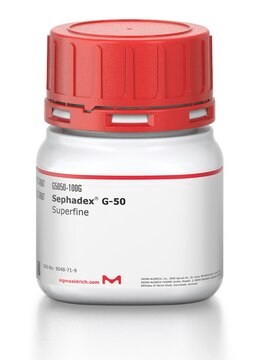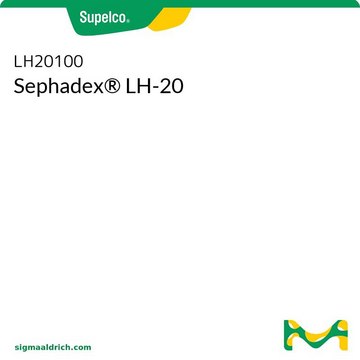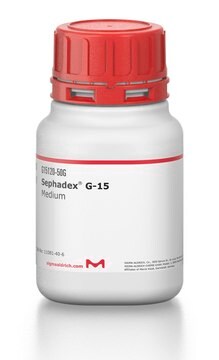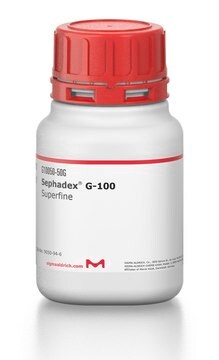G5080
Sephadex® G-50
Fine
Synonym(s):
Gel filtration resin, Sephadex G-50 Fine Medium
Sign Into View Organizational & Contract Pricing
All Photos(2)
About This Item
Recommended Products
Quality Level
technique(s)
affinity chromatography: suitable
matrix active group
phase
swelling
1 g swells to 9-11 mL
bead size
20-80 μm
application(s)
life science and biopharma
compatibility
Cytiva
General description
Sephadex G-50 Fine is a widely used gel filtration resin designed for desalting and buffer exchange of biomolecules with a molecular weight greater than 30,000. Its small bead size contributes to higher efficiency in these processes. Different types of Sephadex vary in terms of cross-linking, resulting in differences in swelling and molecular fractionation range. Sephadex G-50 is one of five G-types available, ranging from G-10 for small molecules to G-75 for larger molecules. Sephadex G-50 comes in four different particle sizes, such as Coarse, Medium, Fine, and Superfine.
Sephadex® G-50 is a gel filtration medium used in affinity chromatography, protein chromatography, and gel filtration chromatography. Sephadex is a beaded gel prepared by crosslinking dextran with epichlorohydrin.
Fractionation Range (MW)
Globular Proteins: 1,500 - 30,000
Dextrans: 500 - 10,000
Fractionation Range (MW)
Globular Proteins: 1,500 - 30,000
Dextrans: 500 - 10,000
Application
Sephadex® G-50 has been used:
- to remove the non-entrapped carboxyfluorescein (CF) from the liposome suspension
- in the purification of monoclonal antibody (mAb) humanized MN-14 by centrifuged size-exclusion chromatography
- in desalting the recombinant enzymes eluted in the fraction five and six
Sephadex® G-50 is suitable for use in:
- the separation of low and high molecular weight molecules
- affinity chromatography, protein chromatography, and gel filtration chromatography
Features and Benefits
- Desalts, removes contaminants, and transfers to a new buffer in one step.
- Suitable for DNA purification from small molecules using gel filtration.
- Features a small bead size, resulting in shorter diffusion distances.
- Considered a classic gel filtration resin.
- Desalting with Sephadex is considered superior to dialysis because it saves time, has a low dilution factor, and recovers high activity even with minute amounts of sample
Other Notes
G5080-100G′s updated product number is GE17-0042-01
G5080-500G′s updated product number is GE17-0042-02
G5080-500G′s updated product number is GE17-0042-02
Legal Information
Sephadex is a registered trademark of Cytiva
replaced by
Product No.
Description
Pricing
Storage Class Code
11 - Combustible Solids
WGK
WGK 3
Flash Point(F)
Not applicable
Flash Point(C)
Not applicable
Personal Protective Equipment
dust mask type N95 (US), Eyeshields, Gloves
Certificates of Analysis (COA)
Search for Certificates of Analysis (COA) by entering the products Lot/Batch Number. Lot and Batch Numbers can be found on a product’s label following the words ‘Lot’ or ‘Batch’.
Already Own This Product?
Find documentation for the products that you have recently purchased in the Document Library.
Customers Also Viewed
L M Weiner et al.
Journal of immunology (Baltimore, Md. : 1950), 151(5), 2877-2886 (1993-09-01)
Bispecific monoclonal antibodies (BsmAb) with specificity for tumor Ag and effector cell trigger molecules have been shown to redirect the cytotoxicity of several peripheral blood mononuclear cell populations against relevant tumor. The BsmAb, 2B1, binds to the extracellular domain of
L Zhang et al.
The EMBO journal, 14(2), 313-320 (1995-01-16)
Heme is a prosthetic group for numerous enzymes, cytochromes and globins, and it binds tightly, sometimes covalently, to these proteins. Interestingly, heme also potentiates binding of the yeast transcriptional activator HAP1 to DNA and inhibits mitochondrial import of the mammalian
Samuel Lopez-Nieves et al.
The New phytologist, 217(2), 896-908 (2017-10-11)
Diverse natural products are synthesized in plants by specialized metabolic enzymes, which are often lineage-specific and derived from gene duplication followed by functional divergence. However, little is known about the contribution of primary metabolism to the evolution of specialized metabolic
B P Brunk et al.
Genetics, 124(1), 145-156 (1990-01-01)
The isolation of gain of function mutations has allowed the identification of a number of genes which are important in the normal development of the organism. We report here the isolation and characterization of Aristapedioid, a gain of function mutation
Jennifer E Dawson et al.
Nature communications, 11(1), 3146-3146 (2020-06-21)
Phosphorylation of intrinsically disordered eIF4E binding proteins (4E-BPs) regulates cap-dependent translation by weakening their ability to compete with eIF4G for eIF4E binding within the translation initiation complex. We previously showed that phosphorylation of T37 and T46 in 4E-BP2 induces folding
Our team of scientists has experience in all areas of research including Life Science, Material Science, Chemical Synthesis, Chromatography, Analytical and many others.
Contact Technical Service










